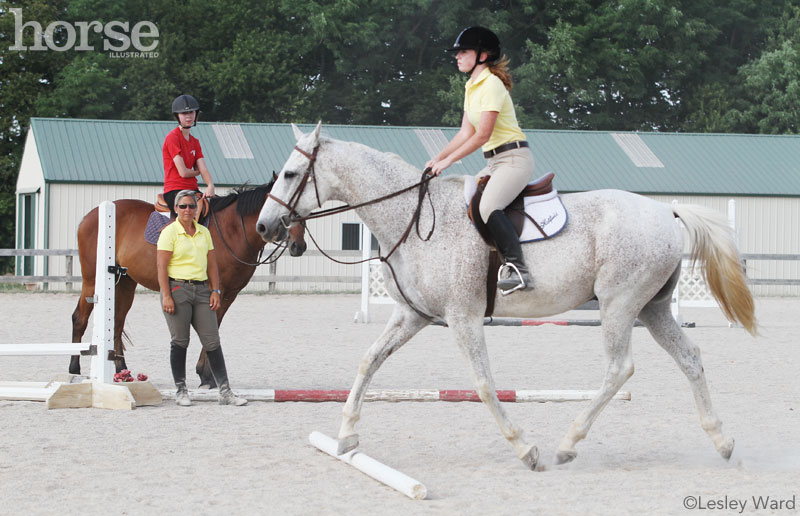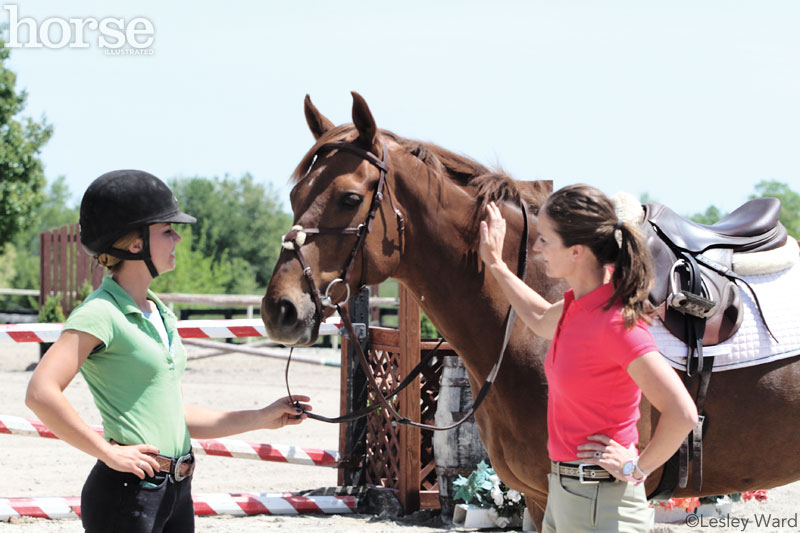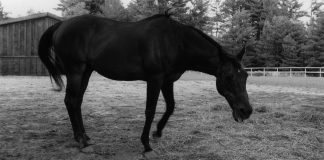There are times in many horse lovers’ lives when they can’t own a horse of their own. That doesn’t mean you have to forgo your horse fix. From lessons to catch rides, leasing, renting, volunteering, and more, there are countless ways to keep horses in your life.

Riding lessons help you improve your knowledge and skill with less of a time and financial commitment than owning or leasing a horse.
Taking Riding Lessons
“I’ve been taking English lessons on a weekly basis for two years now, mainly because I wanted to get more out of my riding experience,” she says. “I’m basically learning from the ground up as an adult, so it’s a continuous learning process that’s challenging and even scary at times, but worth every minute.”
Ludovissy loves the thrill of being in sync with the horse when riding, not to mention the therapeutic qualities of grooming post-ride. “Above all, my ‘horse fix’ time allows me to be in the moment and enjoy the now, something we lose the knack for as we grow up. In a way it helps me be that horse-loving kid again,” she adds.
Pros and cons: The main pros for Ludovissy are that lessons are far cheaper and less time-consuming than ownership. However, the fact that some lesson horses come and go stands out as a big con for her.
Tips for success: “I tried out lots of instructors before clicking with my current one,” says Ludovissy. “It was also important to me that the horses be well cared for, another good reason to go and see things firsthand. Make the most of your lessons by getting into a regular workout routine that’s focused on the needs of equestrians so that you’re strong and ready to ride!”
Catch Riding
Experienced riders often find they get offers to ride other people’s horses, aka catch ride. Nancy Furbee of Pittsburgh, Pa., began working at a barn to earn lessons when she was 10. “I have never owned my own horse,” she says. “I find there are so many people who don’t have the time to ride or just need some help caring for their horse. I also have a number of friends with multiple horses who are always looking for someone to join them for a ride. I always say that I could ride eight days a week if I accepted every offer I had to ride. Not a bad position to be in!”
Allison Griest of Houston, Texas, combines taking lessons and catch riding. “Once I find a barn I really like, it takes a while to establish myself,” she says. “Eventually, opportunities start to present themselves. I do catch riding mostly at English barns. Occasionally, there’s a trail horse that a friend will want hacked while they’re out of town. I pride myself on never telling someone that I’ll train their horse. I just exercise horses, and I try to be a very gentle rider.”
Pros and cons: “I fall in love with every horse I meet, and I learn so much,” says Griest. However, she can’t always get her horse fix how and when she wants.
For Furbee, the cost is a major pro, as is being able to take a break when she wants. The cons: “You must do things as the owner wishes. This includes using their tack, riding style, training and grooming.”
Tips for success: “I think patience and humility are the top things to remember when going this route,” says Griest. She advises not to offer unsolicited advice and to always say thank you.
“Don’t ride every horse offered to you—make sure you will be safe,” adds Furbee. “Take the time to get to know your mounts.” She says that riders should always clean up after themselves and do a little extra to help the owner out, too, such as cleaning tack.

Catch riding gives you the opportunity to ride different horses and help out a horse owner who is unable to ride as often as the horse needs.
Leasing a Horse
Leasing provides a slightly more formal option. There are full leases, where you are almost entirely responsible for a horse that someone else owns, or half leases, where you share the horse with the owner.
Horse Illustrated editor Elizabeth Moyer is currently leasing a horse, and has also half-leased and owned horses in the past. “Leasing gives me the opportunity to ride a nice horse that I wouldn’t be able to buy,” she says. “When I was first starting out, I half-leased my favorite lesson horse, which gave me more riding time as well as hands-on horse care experience without the full expense and commitment of owning. I also wound up buying a horse that I half-leased; that way, I was sure that he was the right horse for me.”
Pros and cons: With leasing, you will usually have more access to the horse than in many other non-ownership scenarios. However, depending on the arrangement, your lease may cost a similar amount to owning a horse.
At the end of the lease term, both parties can re-evaluate. If the situation is no longer working for you, you can give the horse back. On the other hand, the horse’s owner could decide to sell the horse to someone else or take him back.
Tips for success: Make sure each party’s expectations are clear in terms of who is responsible for what, from board and upkeep to routine veterinary and farrier care, as well as emergency situations. To protect both yourself and the owner of the horse, get everything in writing. Good communication is key.
Renting a Ride
Renting can involve a local trail ride or an equestrian vacation. Judy Luchsinger of Eagan, Minn., grew up riding friends’ horses and owned her own horse until job-related moves made it too difficult.
“I’m 76 years old and am considering going on vacation at a guest ranch, where they have lots of horseback riding every day,” she says.
Pros and cons: “Every year or so, I head to a dude ranch to get a complete fix,” says Furbee. “Spending an entire week riding all day long is a great way to ‘own’ a horse and see some fabulous scenery.”
Courtney Schmid of San Marcos, Calif., grew up taking lessons, showing and owning her own pony. As a newlywed starting her life and career, she can’t own a horse at the moment but has tried renting trail horses and volunteering. The main con to renting? “These horses are used to doing the same trails over and over, and they’re on autopilot,” she says.
Tips for success: If you’re renting, find a place where the horses are well cared for, and where you’ll enjoy the scenery. If you’re considering a dude ranch, do your research, and make sure they offer the riding opportunities you seek.
Volunteering with Horses
From therapeutic riding facilities to rescues and everything in between, there are countless opportunities to volunteer with horses. “My long-time friend Molly and I found a rescue that has more than 30 horses,” says Schmid. “Molly and I go to help work the horses, feed and clean. Because it’s a rescue, there are some horses that have special needs, so they require all the help they can get.”
Pros and cons: “There is nothing like owning your own horse, but volunteering is very satisfying,” says Luchsinger, who has volunteered at several places throughout the years.
“Volunteering is special, but it’s a different bond,” agrees Schmid. “However, you save money versus owning. In addition, we can go when we have the time, and if we can’t make it out there one week, it’s OK.”
Tips for success: “Find somewhere close to home or work, or somewhere you enjoy spending time,” says Schmid. “Build relationships with the people and the horses, and just enjoy every moment you have available with the animals.”
Helping at the Barn
Even those who can’t or don’t ride can find ways to get their horse fix. Leah WilliamsSasaki of Long Beach, Calif., worked for lessons as a child and owned several horses. When her horse, Quinn, died in a tragic trailer accident, she took a long break from horses. Eventually, a friend brought her back to a local stable. “I slowly started caring for horses as favors,” she says. “Soon that morphed into paying customers, and now I have a successful grooming business.
“Since my horse passed away, I’ve had three back surgeries and am unable to ride anymore. Working at the stable, I get plenty of horse time, and it helps fill the hole Quinn left.”
Pros and cons: “Not owning a horse is hard some days, but it’s hard to support a horse financially, and it does require 24/7 involvement,” says WilliamsSasaki.
Tips for success: “You have to be tough, not afraid to get dirty, and patient,” she adds. If you want to create a business helping to care for horses, she warns that it’s not a steady paycheck. “You have to be willing to work holidays and sometimes long hours.”
As these resourceful horseless riders prove, where there’s a will, there’s a way to find quality equine time. “I love how the rest of the world disappears when I’m at the barn,” says Furbee.
MICAELA MYERS is the author of The Horse Illustrated Guide to Trail Riding (i-5 Press).
This article originally appeared in the May 2015 issue of Horse Illustrated magazine. Click here to subscribe!







I guess, I should count my lucky stars, for owning my horse and have a farm to keep her on.
I have never ‘owned’ a horse, but wanted to since I was about 5 years old. I have volunteered for a horse rescue foundation now for 15 years. I have known many of the horses there who are now in their 30’s. I have enjoyed a long friendship with many of them, and have been there when it was their time to go. I have had the rich pleasure and joy of knowing they had a good life and end of life. We have 30 horses in our horse herd family and many wonderful lifelong memories.